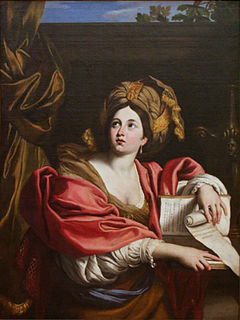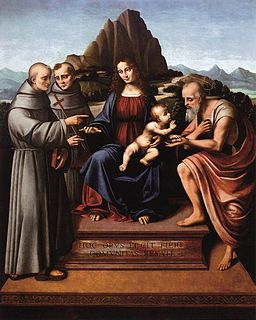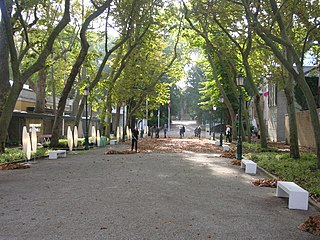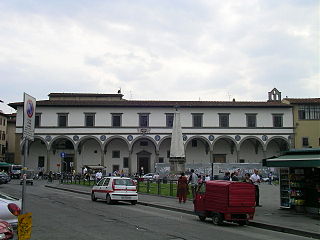 W
WThe Accademia di Belle Arti di Palermo is a public tertiary academy of art in Palermo, Sicily. It was established in 1780.
 W
WThe Accademia di belle arti di Reggio Calabria is an academy of fine arts located in Reggio Calabria, Italy. It was founded in 1967.
 W
WThe Accademia di Belle Arti di Urbino is an academy of fine arts located in Urbino, Marche. It was founded in 1967.
 W
WThe Accademia Ligustica di Belle Arti is a tertiary academy of fine arts located in Genoa, Italy. It also houses a museum, which includes works of Giovanni Benedetto Castiglione, Giuseppe Abbati, Anton Raphael Mengs, Perin del Vaga, Luca Cambiaso, Bernardo Strozzi, Giovanni Battista Paggi, Sinibaldo Scorza, Domenico Fiasella, Luciano Borzone, Serafino De Tivoli, Plinio Nomellini. The academy was founded in 1751.
 W
WAdoration of the Christ Child was a 1431 or 1437 fresco by Paolo Uccello – some of the members of the family which commissioned it are shown. It was originally painted on a wall in the sacristy of San Martino church in Bologna, but it was later hacked off that wall, meaning that only two fragments survive. These are now on show in the first chapel on the left on the north aisle of the church's nave. On one of the fragments is a date starting 143, though it is unclear if the final digit is a 1 or a 7.
 W
WBaita is a term used mainly in Italy and France to refer to small dwellings of the central and western Alps. This word is found from the Lepontine to the Maritime alpine sections.
 W
WCentro per l'arte contemporanea Luigi Pecci is a contemporary art centre sited in Via della Repubblica in Prato, Italy. The centre is devoted to exhibiting art produced during the past few decades. It houses a Museum of Contemporary Art, a Centre of Information and Documentation of visual arts and an education department. Originally designed by architect Italo Gamberini, in 2016 it was expanded by Maurice Nio, who designed a U-shaped building with an outdoor amphitheater with a seat capacity of 800 people at the centre. In addition to the permanent contemporary art collection, the centre includes a sculpture garden and a space designated to the installation of temporary exhibitions.
 W
WThe Turin Civic Museum of Ancient Art is a museum located in the Palazzo Madama palace, in Turin, Italy.
 W
WCleopatra is a 1611-1612 oil on canvas painting of Cleopatra by Artemisia Gentileschi, now in the private Etro collection in Milan.
 W
WThe Museum of Contemporary Art of Rome, Italian: Museo d'Arte Contemporanea di Roma, usually known as MACRO, is a municipal contemporary art museum in Rome, Italy. The museum is housed in two separate places: a former brewery in Via Nizza, in the Salario quartiere of the city; and a former slaughterhouse in Piazza Orazio Giustiniani, in the quartiere of Testaccio.
 W
WCreation and the Fall are a pair of 1420-1425 frescoes by Paolo Uccello, produced for the Chiostro Verde in Santa Maria Novella in Florence. As with the other frescoes in the cloister, it shows scenes from the Book of Genesis in monochrome, terra verde or "verdeterra", a pigment based on silica and iron oxide. The upper lunette shows Creation of the Animals and the Creation of Adam and the rectangular work below shows Creation of Eve and the Fall. Both works have now been transferred to canvas and were restored in 2013-2014, after which it was considered moving them to an internal room within the complex.
 W
WThe Cretto di Burri or Cretto di Gibellina, also known as "The Great Cretto", is a landscape artwork undertaken by Alberto Burri in 1984 and left unfinished in 1989, based on the old city of Gibellina. The original city of Gibellina was completely destroyed in the 1968 Belice earthquake. Gibellina has since been rebuilt, about 20 km from the city's original location. In 2015, to mark what would have been Burri's one hundredth birthday, the work was finally completed.
 W
WThe Sibilla Cumana is a painting by the Italian Baroque painter Domenicho Zampieri (Domenichino) housed in the Capitoline Museum in Rome, Italy.
 W
WThe D2.0-Box is an Italian gallery of modern art and contemporary art in Caserta da Angelo Marino. It is associated with the contemporary art gallery dirartecontemporanea 2.0.
 W
WThe Diocesan Museum of Milan is an art museum in Milan housing a permanent collection of sacred artworks, especially from Milan and Lombardy. Originally conceived by Ildefonso Schuster in 1931 as a vehicle to protect and promote the art collection of the Archdiocese of Milan, the museum was eventually established in the former headquarters of the Dominican Order in the back of the Basilica of Sant'Eustorgio with the support of Pope Paul VI. In 2001 Carlo Maria Martini inaugurated the current venue located in Porta Ticinese.
 W
WThe Engineer's Lover is a painting by Italian painter Carlo Carrà. It was finished during the metaphysical phase of the artist (1921).
 W
WThe Fall of Man is a painting of the Fall of Man or story of Adam and Eve by the Venetian artist Titian, dating to around 1550 and now in the Prado in Madrid. It is influenced by Raphael's fresco of the same subject in the Stanza della Signatura in the Vatican, which also had a seated Adam and standing Eve, as well as Albrecht Dürer's engraving Adam and Eve for smaller details. Owned at one point by Philip II of Spain's secretary, Antonio Pérez, and perhaps first commissioned by his father, in 1585 it entered the Spanish royal collection, where it was copied by Rubens between 1628 and 1629 for his own version of the subject.
 W
WThe Floating Piers was a temporary, site-specific work of art by Christo and Jeanne-Claude, consisting of 70,000 square meters of yellow fabric, carried by a modular floating dock system of 226,000 high-density polyethylene cubes installed in 2016 at Lake Iseo near Brescia, Italy. The fabric created a walkable surface between Sulzano, Monte Isola and the island of San Paolo.
 W
WThe Fontignano Madonna is a 1522 fresco Madonna and Child by Perugino. Angniolus Toni Angeli and the Confraternity of the Annunciation commissioned him to decorate their church of S. Maria dell'Annunziata in Fontignano in 1521. It is his only surviving work in the church and probably reused his cartoons from Santa Maria Maggiore in Spello, such as those for the Spello Pietà. Angeli's name appears at the base of the work.
 W
WThe Forlivese school of art was a group of Italian Renaissance painters and other artists. Most were born in Forlì or near it in the Emilia-Romagna region of Italy. Some other artists went to Forlì to study.
 W
WThe Galleria d'Arte Moderna of Bologna is the modern art museum of the city. It has five exhibition venues: MAMbo, the Museo d'Arte Moderna di Bologna; the Villa delle Rose; the Museo Morandi; Casa Morandi; and the Museo per la Memoria di Ustica. The collections consist of more than 3,500 items of modern and contemporary art.
 W
WThe Galleria Nazionale d'Arte Antica (GNAA), or National Gallery of Ancient Art, is an art gallery in Rome, Italy, the main national collection of older paintings in Rome. It has two sites: the Palazzo Barberini and the Palazzo Corsini.
 W
WThe Venice Giardini or Giardini della Biennale is an area of parkland in the historic city of Venice which hosts the Venice Biennale Art Festival, a major part of the city's cultural Biennale. The gardens were created by Napoleon Bonaparte who drained an area of marshland in order to create a public garden on the banks of the Bacino di San Marco which is a narrow stretch of water dividing the gardens from St. Mark's Square and the Doge's Palace.
 W
WHoly Trinity is a fresco in San Severo chapel in San Severo church in Perugia, executed by Raphael and Perugino.
 W
WLife of the Virgin or Scenes from the Life of the Virgin Mary is a 1525 cycle of frescoes by Lorenzo Lotto in the chapel to the left of the Cappella Maggiore in San Michele al Pozzo Bianco in Bergamo - it was the last work the artist produced in the city. Outside the chapel is a work showing The Visitation, whilst the main four paintings of the cycle show The Birth of the Virgin, The Presentation in the Temple, Betrothal of the Virgin and The Annunciation. Above these are a dome and four pendentives showing the Evangelists.
 W
W'Madonna of Graces with Two Saints is a 1522 fresco painting by Perugino. Its central figure shows Mary as Our Lady of Graces, flanked by Antony the Great and Antony of Padua. It is in a side chapel of the church of Sant’Agnese, the Poor Clares convent in Perugia. It was commissioned a year before the painter's death by Eufrasia and Teodora, two nuns of the convent.
 W
WThe Martyrdom of St Sebastian is a 1505 fresco painting by Perugino in the church of San Sebastiano in Panicale. It shows the martyrdom of St Sebastian in an ancient Roman setting, with God the Father in a tondo above.
 W
WThe Museo archeologico e d'arte della Maremma is an archaeological and art museum in Grosseto, Tuscany, Italy.
 W
WThe Museo Collezione Gianfranco Luzzetti is an art museum in Grosseto, Tuscany, Italy.
 W
WMuseo d'Arte Moderna Vittoria Colonna is a modern art museum in Pescara, Abruzzo.
 W
WThe Museo dell'Opera del Duomo in Florence, Italy is a museum containing many of the original works of art created for the Cattedrale di Santa Maria del Fiore, the cathedral (Duomo) of Florence. As of August 2013, the director of the museum is Fr. Timothy Verdon, an American.
 W
WThe Museo Nazionale Alinari della Fotografia, formerly Museo della Storia della Fotografia Fratelli Alinari is a photography museum located in part of the premises of the former Ospedale di San Paolo in the Piazza Santa Maria Novella in Florence, region of Tuscany, Italy). It hosts special exhibitions on a regular basis and possesses 350.000 vintage prints from the 19th and 20th centuries.
 W
WThe Civico Museo Sartorio is a museum in Trieste, northern Italy. Set in an urban villa, it exhibits ceramics, majolica, porcelain and pictures, typical equipment of Trieste's villas at the end of the 19th century.
 W
WThe Edoardo Chiossone Museum of Oriental Art in Genoa is an important collection of Asian art, one of the most significative collections in Europe and in Italy, along with the museums of Venice and Rome.
 W
WMuseo Nivola in Orani, Sardinia, Italy is an institution devoted to the work of artist Costantino Nivola within the larger context of contemporary art, landscape and living traditions.
 W
WNove Ware is a type of maiolica, or tin-glazed earthenware. It was made in Nove, Italy, in the 18th century, mainly in a factory founded by Giovanni Battista Antonibon in 1728. Near the end of the 18th century the factory became associated with another factory, in nearby Bassano, where majolica was produced in the 16th century. Nove ware was fashioned in the Rococo style common in the 18th century, with an emphasis on light, decorative works that conformed to a sense of stylistic elegance, as opposed to the ebullient style of the baroque.
 W
WThe Palazzo Riso, or RISO, Museo d’Arte Contemporanea della Sicilia, is a regional contemporary art museum located in the ancient Corso Vittorio Emanuele, Palermo, Italy.
 W
WThe Parting of Lot and Abraham is one in a series of mosaic scenes, probably dating to the 430s, that decorate the nave wall of Santa Maria Maggiore, one of the most prominent basilican churches in Rome. The mosaic shows the story in the biblical Book of Genesis of the parting of Abraham from his nephew, Lot, as they choose opposing paths. Abraham with Isaac and the rest of his family, chooses the road to Canaan, as God intends him to, and Lot chooses to take his followers to Sodom.
 W
WThe Pietà or Christ's Body Supported by the Virgin Mary and St John the Evangelist is a tempera on panel painting by Giovanni Bellini, now in the Accademia Carrara in Bergamo. Dated to around 1455, it is one of his earliest independent works and the prototype for his series of pietàs. It draws on Byzantine icons of the 'imago pietatis', of which there were many examples throughout Venice, and of 'Ritratti di Passione' or 'portraits of the Passion', in which the dead Christ invites the viewer to contemplate his wounds. The crossed arms are drawn from a famous Roman mosaic-icon from Santa Croce in Gerusalemme basilica which was held to be miraculous and had according to legend been commissioned by pope Gregory the Great based on a vision during a mass.
 W
WThe Pinacoteca Giovanni e Marella Agnelli is an art gallery in Turin, Italy. It opened in 2002 on the top floor of the Lingotto complex, where a "scrigno" or 450 square-metre steel structure designed by Renzo Piano is raised 34 metres off the test track on the roof of the plant. Its style represents a crystal spaceship, referring back to the original building's futuristic style. Its permanent collection is a selection of paintings and sculptures from Gianni and Marella Agnelli's private collection such as Renoir's Blonde Bather and Manet's La Négresse as well as paintings by Matisse, Canaletto, Tiepolo, Canova, Piscasso and Modigliani. The gallery also puts on temporary modern art exhibitions.
 W
WThe Pinacoteca metropolitana di Bari or Painting Gallery of Metropolitan City of Bari is a public gallery of paintings and museum of artworks in the city of Bari, Italy.
 W
WThe Pinacoteca Nazionale is a national museum in Siena, Tuscany, Italy. Inaugurated in 1932, it houses especially late medieval and Renaissance paintings from Italian artists. It is housed in the Brigidi and Buonsignori palaces in the city's center: the former, built in the 14th century, it is traditionally identified as the Pannocchieschi family's residence. The Palazzo Bichi-Buonsignori, although built in the 15th century, has a 19th-century neo-medieval façade based on the city's Palazzo Pubblico.
 W
WThe Plato and Diogenes is a painting by the Italian Baroque painter Mattia Preti and housed in the Pinacoteca of the Capitoline Museum in Rome, Italy.
 W
WThe Polyphemus is an oil on canvas painting by the Italian Baroque painter Guido Reni, executed in 1639–1640, and housed in the Pinacoteca of the Capitoline Museum in Rome, Italy.
 W
WThe Porcelain Museum is located in the Casino del Cavaliere, one of the highest points of the Boboli Gardens at the Pitti Palace in Florence, Italy.
 W
WThe Portrait of Lucrezia Panciatichi is a painting by the Italian artist Agnolo di Cosimo, known as Bronzino, finished around 1545. It is housed in the Uffizi Gallery in Florence, Italy.
 W
WThe Rocca Flea is a fortified palace in Gualdo Tadino, Umbria, central Italy. It is located in the upper part of the hill on which the town lies.
 W
WSaint Agatha's Vision of Saint Peter in Prison is a c.1625 oil on canvas painting by Simon Vouet, showing the imprisoned Agatha of Sicily having a vision of a visit from Peter the Apostle, who heals her wounds. It is now in the Galleria Regionale del Palazzo Abatellis in Palermo, which it entered from the former Jesuit college in Cassaro.
 W
WThe Spello Pietà is a fresco of the Pietà by Perugino executed in 1521–1522. It also shows John the Apostle and Mary Magdalene kneeling either side of the Virgin Mary. It is now sited in the left transept of the Chiesa Santa Maria Maggiore in Spello, but its origins are unknown.
 W
WVenise, La Piazzetta seen from the Riva degli Schiavoni is a c. 1835-1845 painting of Venice by French artist Jean-Baptiste-Camille Corot. The painting is at the Norton Simon Museum in Pasadena, but as at 2019 not on display.
 W
WThe Verismo refers to a 19th-century Italian painting style. This style was practiced most characteristically by the "Macchiaioli" group of painters, who were forerunners of the French Impressionists.